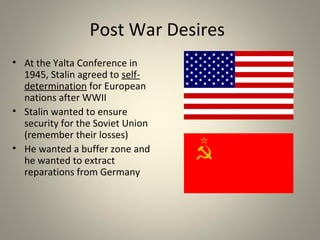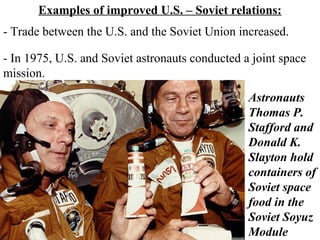The document provides background information on the early Cold War period from 1947 to 1970. It discusses key events like the Truman Doctrine and Marshall Plan that established the US policy of containment of communism. It also covers the establishment of military alliances like NATO and the Warsaw Pact, proxy wars in Korea and Vietnam, and crises over places like Berlin, Cuba, and Czechoslovakia. The arms race between the US and USSR is examined, as well as the emergence of the Non-Aligned Movement led by countries seeking to avoid alignment with either superpower.










![Ominous Words
• "From Stettin on the Baltic to
Trieste on the Adriatic, an iron
curtain has descended across
the continent [of Europe].
Behind that line lie all the
capitals of the ancient states of
central and eastern Europe....
All these famous cities and
populations lie in what I must
call the Soviet sphere."](https://image.slidesharecdn.com/coldwar-myedit-140508074048-phpapp01/85/Cold-War-in-a-Global-Context-11-320.jpg)





![The Ideological StruggleThe Ideological Struggle
Soviet &
Eastern Bloc
Nations
[“Iron Curtain”]
US & the
Western
Democracies
GOAL spread world-
wide Communism
GOAL “Containment”
of Communism & the
eventual collapse of the
Communist world.
[George Kennan]METHODOLOGIES:
Espionage [KGB vs. CIA]
Arms Race [nuclear escalation]
Ideological Competition for the minds and hearts
of Third World peoples [Communist govt. &
command economy vs. democratic govt. & capitalist
economy] “proxy wars”
Bi-Polarization of Europe [NATO vs. Warsaw Pact]](https://image.slidesharecdn.com/coldwar-myedit-140508074048-phpapp01/85/Cold-War-in-a-Global-Context-17-320.jpg)

![Truman Doctrine [1947]Truman Doctrine [1947]
1.1. Civil War in Greece.Civil War in Greece.
2.2. Turkey under pressure from theTurkey under pressure from the
USSR for concessions in theUSSR for concessions in the
Dardanelles.Dardanelles.
3.3. The U. S. should support freeThe U. S. should support free
peoples throughout the world whopeoples throughout the world who
were resisting takeovers by armedwere resisting takeovers by armed
minorities or outside pressures…Weminorities or outside pressures…We
must assist free peoples to work outmust assist free peoples to work out
their own destinies in their own way.their own destinies in their own way.
4.4. The U.S. gave Greece & TurkeyThe U.S. gave Greece & Turkey
$400 million in aid.$400 million in aid.](https://image.slidesharecdn.com/coldwar-myedit-140508074048-phpapp01/85/Cold-War-in-a-Global-Context-19-320.jpg)
![Marshall Plan [1948]Marshall Plan [1948]
1.1. ““European RecoveryEuropean Recovery
Program.”Program.”
2.2. Secretary of State,Secretary of State,
George MarshallGeorge Marshall
3.3. The U. S. should provideThe U. S. should provide
aid toaid to allall European nationsEuropean nations
that need it. This movethat need it. This move
is not against any country or doctrine,is not against any country or doctrine,
but against hunger, poverty, desperation,but against hunger, poverty, desperation,
and chaos.and chaos.
4.4. $12.5 billion of US aid to Western$12.5 billion of US aid to Western
Europe extended to Eastern Europe &Europe extended to Eastern Europe &
USSR, [but this was rejected].USSR, [but this was rejected].](https://image.slidesharecdn.com/coldwar-myedit-140508074048-phpapp01/85/Cold-War-in-a-Global-Context-20-320.jpg)

























































![““Prague Spring” Dashed!Prague Spring” Dashed!
Dissidents/playwrights arrested [likeDissidents/playwrights arrested [like
Vaclav HavelVaclav Havel—future president of a free—future president of a free
Czech RepublicCzech Republic].].](https://image.slidesharecdn.com/coldwar-myedit-140508074048-phpapp01/85/Cold-War-in-a-Global-Context-78-320.jpg)





































